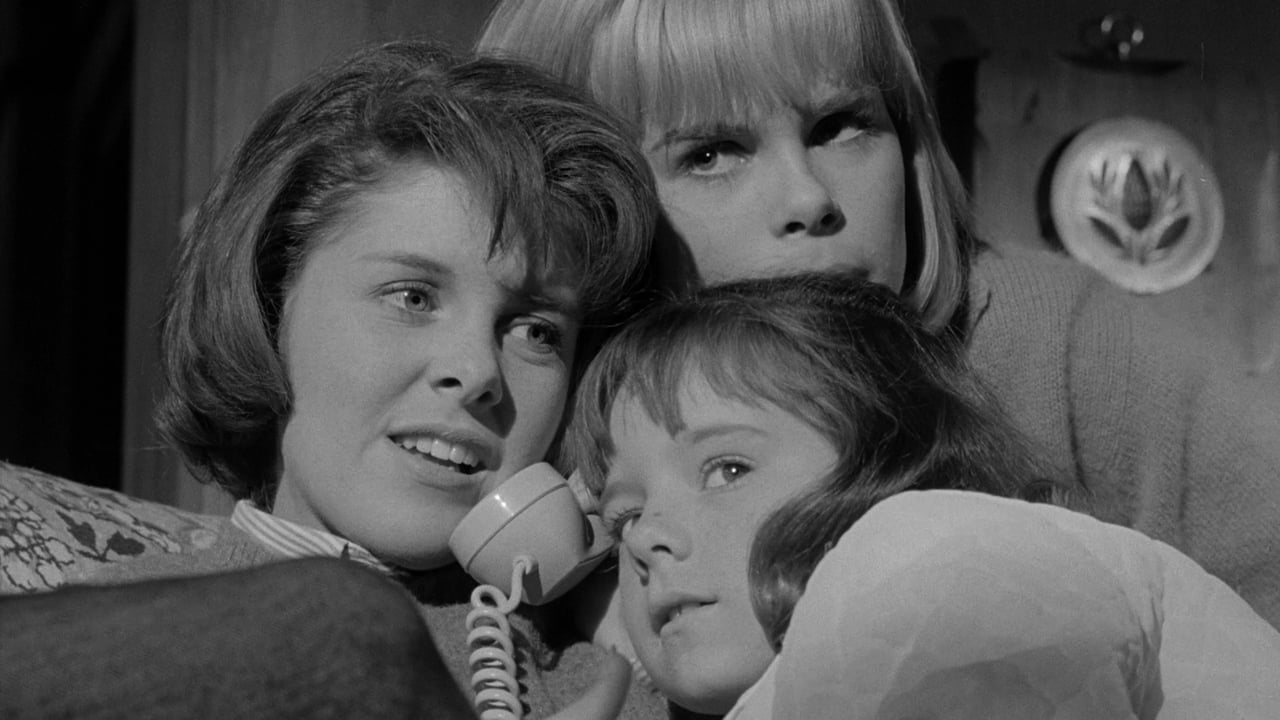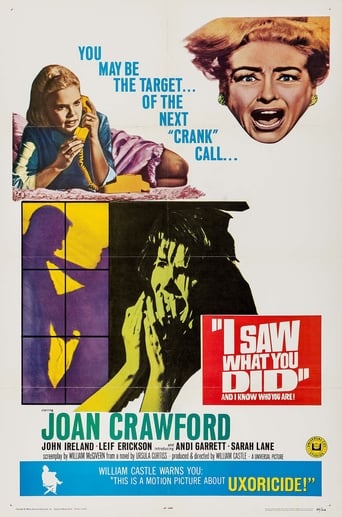

Simply Perfect
... View Morerecommended
... View MoreAn action-packed slog
... View MoreThis is a small, humorous movie in some ways, but it has a huge heart. What a nice experience.
... View More"I saw what you did...and I know who you are!" This is what teenagers Kit and Libby say to Steve Marak (John Ireland), whom they've randomly dialed as a prank. Trouble is, they don't know that Marak's just killed his wife, who was about to leave him, and has buried her in a shallow grave. Now he thinks his mysterious caller knows too much - and he's out to find her.This is another post-gimmick horror movie from the legendary William Castle, and like The Night Walker and Strait-Jacket, there are plenty more genuine scares than campy laughs. This is also the kind of movie that couldn't quite be duplicated in this day and age, of course. The girls find their numbers not by just dialing random digits but by picking names out of the phone book. That's because back then, many numbers weren't even used (even though the full number consisted of a two-letter designation for the town/exchange and then five numbers), so Kit and Libby could have tried a score of phone numbers before getting an answer.But the use of the phone book adds to the story in another way. Kit and Libby think Steve's voice sounds darn hunky, so they decide to snag Libby's mom's car and head to good ol' Steve's house. You know, just to see what he looks like. Late at night. They're not even going to get out of the car! They drag along Libby's kid sister Tess, because they're not going to leave her alone in their secluded forest house! They're responsible! There's a side plot. Steve's a little crazed (even before killing his wife, played by Joyce Meadows), but he's almost stable compared with his neighbor Amy, played by the inimitable Joan Crawford. Amy is obsessed with Steve - it's unclear whether they'd been having an affair, but Amy's intentions are transparent - to the point where, once she realizes what Steve's done, she attempts to blackmail him into marrying her and having a whopping fun life together. It's wacked-out Crawford at her late-career best. This was supposed to be a cameo, but she nails the role so perfectly that she gets extra time for bad behavior.Prank calls, kids. They were a bad idea in 1965, and they're a really bad idea in 2014, when anyone can either tell who is calling them or call them back with that old standby the *69. You know, for those who don't have call-waiting. So you can't pull this malarkey nowadays - too likely that you get some crazed lunatic with no sense of humor.Another fun Castle thriller with some pretty solid work from even the kid actors (Sara Lane, Andi Garrett, Sharyl Locke). The moody fog surrounding the isolated home also sets the perfect tone for an underrated thriller.
... View MoreIn my earlier review of William Castle's HOMICIDAL (1961), I had stated that not only was that film obviously patterned on Alfred Hitchcock's PSYCHO (1960) but also that it looked forward to the "Grand Guignol" cycle that followed in the wake of the critical and box-office success of Robert Aldrich's WHAT EVER HAPPENED TO BABY JANE? (1962) which had obviously co-starred Joan Crawford. Well, the film under review (which, incidentally, also features Crawford) is not only the third of four successive 'official' Castle efforts in that vein – including the bona- fide superior Crawford star vehicle STRAIT-JACKET (1964) – but also subverts two of PSYCHO's most infamous elements: the nominal star of the film here shows up more than half-way through its running-time but still gets bumped off well before the end; and while there is a (very effective, I might add) shower murder sequence here too, it is the killer who is naked under the faucet and is surprised by his aggressive victim, his departing wife!! Despite all these derivations and influences, I SAW WHAT YOU DID itself got remade for TV in 1988, not to mention inspired the "slasher" mini-franchise I KNOW WHAT YOU DID LAST SUMMER more than 30 years later Unfortunately, for all the atmospherically fog-laden black-and-white lighting and decent star names in the cast list (which, curiously, also includes male actor John Crawford as a providential highway patrolman!), the prototype does not perhaps hold up as well as expected in retrospect. Indeed, despite all three being billed ahead of the title, only psychopathic villain John Ireland gets a meaty role and a considerable amount of screen time; on the other hand, as already mentioned above, Crawford's unflattering part of Ireland's overzealous, overcoiffeured and ultimately blackmailing neighbour is only a star cameo (and her last appearance in a Hollywood feature film to boot!), while Leif Erickson's businessman father is just an unconvincing excuse to get the parents away from home for the night so that the trio of girl protagonists can indulge in the titular prank and resultant danger! Even that joke is played out for far more than it is worth and, like the cutaways to the elders' bland dinner engagement, gets to feel repetitive before long. Thankfully, the actresses chosen to fill in the shoes of the menaced pranksters are an engaging lot even if Castle's reprise of the upbeat opening music cue (heard over the credits cleverly displayed through opening and shutting eyes!) for the ending was perhaps a bit misjudged seeing how the two sisters had just been threatened by a knife-wielding serial killer! Incidentally, for the typically ingenious ad campaign for the film, Castle proudly proclaimed to cinema patrons that the film they were about to watch involved "uxoricide" and had selected seats strapped with belts intent on keeping viewers from leaping out of them in shock!
... View MoreI Saw What You Did opens with an eye-hole 'peep' matte shot (keyhole effect in full play) which also links the two main characters (teenage girls) as they get into a phone conversation preparing for a sleepover. This opening shot is both specular and cleverly ironic, which would bode well for this Castle film. Another element playing in Castle's favor is the casting of Joan Crawford. Castle's direction is compellingly and compulsively off and with no perceivable explanation as the script is fresh enough and the characters are fun and dynamic. The shot-reverse-shot and tableau framing creates a sense of camp. There is a splattering of oblique framing aptly creating an unobtrusive camera, however other elements such as the heavy shadows of a uninspired noir lighting setup do not fir with the theme and therefore no stable mood is created and the pace of narrative progression suffers. There is good humor with the crank calling and the shower scene is dramatic and well choreographed. Castle is again ahead of his time (or of the A-picture studio system at least) as he plays around with a psychologically attractive theme that would be replayed in the genre through films such as When a Stranger Calls (1979) and of course Wes Craven's Scream. The film is psychological and carries a significant traditional young female voice in its thematic. There is an idea purveyed that a young woman can take care of herself and stay safe just by talking her way through potential trouble. Castle proved long ago that he has a touch for evoking self-reflexivity within the film text and with the spectator. A good use of a mirror in this film underscores that point. There is an incredibly provocative shot constructed with intuition and style where the child and killer are framed in deep staging (so why the cheesy jewelbox cover). My primary complaint about this film is that Crawford's character needed more involvement in the script and more screen time. . This is a fun film worth watching, but many oversights keep it from being a great film.
... View MoreLibby Mannering's parents are going out for the night. The regular sitter had to cancel because of illness, so the elder Mannerings figure Libby can take care of herself and her younger sister Tess. Kit Austin, a friend of Libby's, is coming to spend the night with her friend. Libby is into mischief. She loved to make phone crank calls at random, so she proposes a game: how about calling people for kicks. Libby concoct stories as she goes along. Kit has second thoughts, but goes along with her friend.The people that answered the girls first calls took the prank in stride, but not so Steve Marak. When he answers the phone, Libby, pretending to be older and more sophisticated, proceeds to tell the man she saw what he did. Had he been another man, he would have dismissed the statement, but not so Steve, for a reason: he had just killed his wife, who was in the process of leaving him. So Steve's guilt feelings begin to get the best of him since he had figured he had covered his tracks.Added to the suspense is a woman of a certain age, Amy Nelson, a neighbor, who had set her eyes on Steve as a possible romantic partner. Steve, who had no intentions of starting anything with Amy, goes to bury the body of his slain wife. Amy figures there is something more to the man she likes, than really meet the eye. Amy begins spying on Steve to see what really is going on with him.When the girls, on a whim, decide to visit Steve's house, they had no idea as to how deep they had gotten and the mess they had created. Amy, noticing the girls outside Steve's house, figures the young women are up to no good. Amy pushes her luck with the man she wants and does not live long after her would be lover decides to eliminate her. Now Steve must get back to the teenagers to get rid of them.Not having seen the film before, we decided to take a look when it showed up on cable recently. This was a William Castle product, a man that had great success in the horror genre. The director enjoyed a long career in the movies, but he was not lucky in the way he planned to present the film. The premise was good. Of course, it is dated, by today's standards when not many people engage in those pranks, something that is not easily condoned, or justified by present laws that would consider Libby's actions as a kind of harassment, punishable by law. Basically, our main interest in watching was to see Joan Crawford, who is featured in the film, but whose presence is only minor within the context of the narrative. John Ireland does not impress as Steve. The production is made more creepy by the use of a fog that envelops most of the scenes involving the suburban house.
... View More